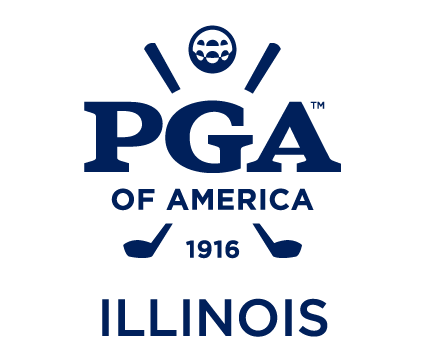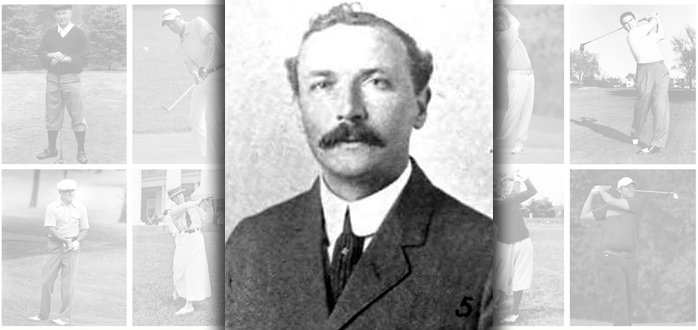The man behind the name on the trophy.
William Marshall came to America with a great pedigree, and proceeded to exceed it.
Born in St. Andrews, Scotland in 1878 and rooted in golf from his earliest days, Marshall appears to have arrived in the U.S. as a 19-year-old, and went to work at the Onwentsia Club in 1897. Specifics as to his position are vague, as his employ there was only mentioned in stories upon his return two years later, but he clearly made a good impression.
When, in the fall of 1897, he won the job of greenkeeper at Milwaukee Country Club – which also carried with it the job of professional at the young club, such double duty commonplace in the early years of American golf, as it was in Scotland – the golf writer for the Milwaukee Journal was effusive in his praise for the lad.
“Marshall is a fine golfer, playing a very strong game himself, an expert club maker, and probably the best teacher in America,” the Journal reported when hiring was announced late in 1897. “Moreover, he has a singularly pleasing manner which makes him popular with all who associate with him, either as pupils or opponents. With the great advantage of a really first class professional always on the grounds, it may be expected that our club will occupy next year a much more prominent position in western golfing circles than heretofore.”
By April of 1898, Marshall was being referred to as MCC’s “instructor,” and by July, the club’s professional. In August, he visited Onwentsia for a pro tournament, and while his 36-hole score of 179 placed him in a tie for sixth, 25 strokes behind winner – and host professional – James Anderson, it could have been this visit that began his return to Onwentsia to stay.
Marshall was back at the Lake Forest club in 1899, Anderson having gone back to Scotland, joined by Peter Walker, the Scot who had been stationed at Lake Geneva. Marshall would teach and make clubs.
He quickly reestablished himself as a favorite of the membership, and when Walker left to return to his schoolteacher duties in Edinburgh at the end of the season, Marshall was named the head professional. The man so many called Willie clearly had made his mark as a clubmaker. Previewing the 1900 season, Inter Ocean golf writer Joseph Ryan wrote, “His clubs made quite a hit with the participants in the amateur championship at Lake Forest last year, and a few of them returned without taking a sample of Marshall’s work along.”
Other professionals came and went at Onwentsia for the next two decades, including Tom Vardon, Harry’s brother, but Marshall was a fixture, running the shop, supervising and taking a hand in custom clubwork, and giving lesson upon lesson to the Onwentsia membership. To that end, the club turned out crack player after crack player.
In the next two decades, 19 Onwentsia players qualified for match play in the Western Amateur, and two of them, David Forgan and William Waller, won it, capturing the first two playings.
What Marshall wasn’t was a great player. He was good, occasionally among the top 10, as evidenced by finishing sixth in the inaugural Western Open of 1899, but didn’t win any titles that made headlines.
But behind the scenes, Marshall was a champion. He was active in the affairs of the old Western Professional Golfers Association, which preceded the PGA of America, and influential informally as well.
When the Middle States Section of the PGA was renamed the Illinois Section late in 1921, a new slate of officers was needed, and Marshall was elected first vice president, working alongside president Joe Roseman and the other officers.
In the winter, Marshall did as so many pros did, holding down a winter job at Bisbee Country Club in Arizona for several seasons. But
Onwentsia was his main job, and he did it unfailingly. Unlike many pros imported from Scotland, he was married, with two sons and two daughters, an indication of stability.
In the late winter of 1921-22, Marshall fell ill with pleurisy, an inflammation of the lung walls. On March 20, 1922, Marshall died, only 48. Two days later, his funeral was held in the Lake Forest Presbyterian Church. Onwentsia members were in the pews, along with what the Chicago Tribune reported as “scores of Lake Forest citizens, many caddy boys, and about twenty-five of the local golf professionals” on hand.
The significance of the turnout of his peers was brought home several months later, when, after discussions following Eddie Loos’ victory in the first Illinois PGA Section championship, it was decided it was only fitting to name the trophy for the championship in his honor. Thus, in 1923, the Willie Marshall Memorial Trophy was first played for. The original trophy still has Marshall’s name engraved upon it.

